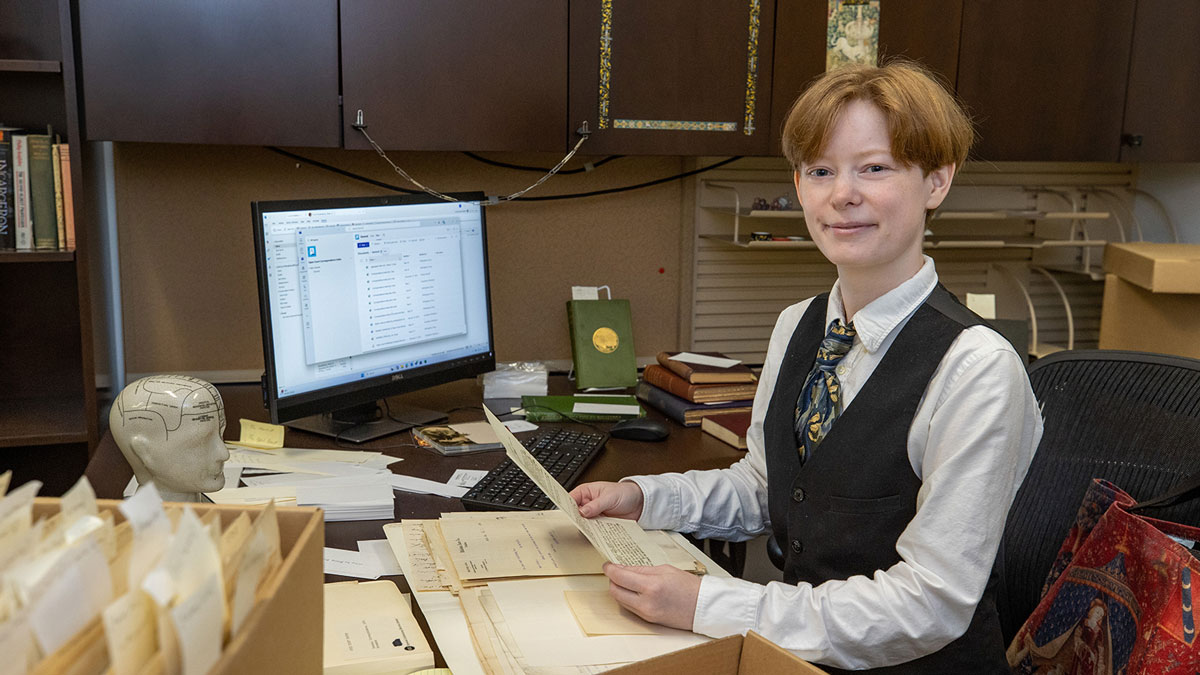
Percy Rottinghaus, a special collections research specialist with SIU Carbondale’s Morris Library, prepares an exhibition that will explore the early decades of anthropology. (Photo by Russell Bailey)
August 07, 2025
SIU exhibition offers insight into early anthropology development, mistakes
CARBONDALE, Ill. — An exhibition in Southern Illinois University Carbondale’s Morris Library that starts on Monday, Aug. 18, will explore the early decades of anthropology.
“A Study of Man: The Growing Pains of 19th and 20th Century Anthropology,” in the library’s Hall of Presidents and Chancellors, will examine the development of anthropology and the academic study of humanity, including “the growing pains and ‘bad science’ involved in the development of the field.” The exhibition will also look at “the intersection of genuine scientific inquiry on one hand and the ways it was often used as a tool of racism and colonialism on the other,” said Percy Rottinghaus, a special collections research specialist with the library.
Highlighting a selection of items from the Open Court Publishing Company archives and rare books from the library’s Special Collections Research Center, Rottinghaus hopes the exhibition provides visitors a glimpse of “scholars trying to understand humanity and its origins and trying to establish the human experience as something that could be measured and studied” but also “how some of these more incorrect and harmful ideas affected the academic conversation in the 19th and 20th centuries.”
The free, public exhibition, which ends Sept. 19, will be open from 8:30 a.m. to 4:30 p.m. Monday through Friday. There is also an accompanying online exhibit that goes into more extensive detail about some of the featured items and their historical context and includes additional documents and resources, Rottinghaus said.
Varied look at anthropology
The exhibition will consist of books from the 1890s and early 1900s on anthropology, sociology and criminology, photographs, excerpts from the Open Court journal and chosen pieces of Open Court Publishing Company correspondence. The Open Court was a multidisciplinary academic journal published monthly between 1887 and 1936 covering a wide range of fields, including science, philosophy, religion and literature, Rottinghaus said.
Rottinghaus said he got the idea for the exhibition while he was indexing the Open Court correspondence collections and researching “recurring and notable correspondents.” He planned to create an exhibit with a historical perspective on pseudoscience and “weird science,” but eventually decided to narrow the focus to the history of anthropology in particular.
“This topic is relevant because it’s important to know the history of different disciplines — both the good and the bad — and how they’ve changed over time,” he said. “I also think it’s interesting to explore how people in the past thought about the world and how they thought about themselves as human beings.”
Research field grew in 19th century
Rottinghaus said many research fields, particularly in the humanities, became established “on an institutional level” in the 1800s, including sociology, psychology and anthropology.
“The spread of the theory of evolution in the 1800s led to a lot of interest in the origins and evolution of humanity, in both a philosophical and a scientific sense, inspiring a surge of anthropological research,” he said. “As with all developing scientific fields, early anthropology had a lot of practices we now know are inaccurate or pseudoscientific that were phased out over time as research methods and standards improved.”
Rottinghaus noted that the field during that era was also “heavily influenced by the colonialist and racist ideas of the time, and many researchers had a vested interest in developing ‘scientific’ reasons for why upper-class white Europeans were better than, and different from, everyone else.
“Even people who were very progressive by the standards of the time would still hold beliefs such as, for example, different ethnicities being more prone to specific types of crime because of inherent biological traits. It took a lot of effort and research to prove that these ideas were wrong and to move the field forward to where it is today.”
